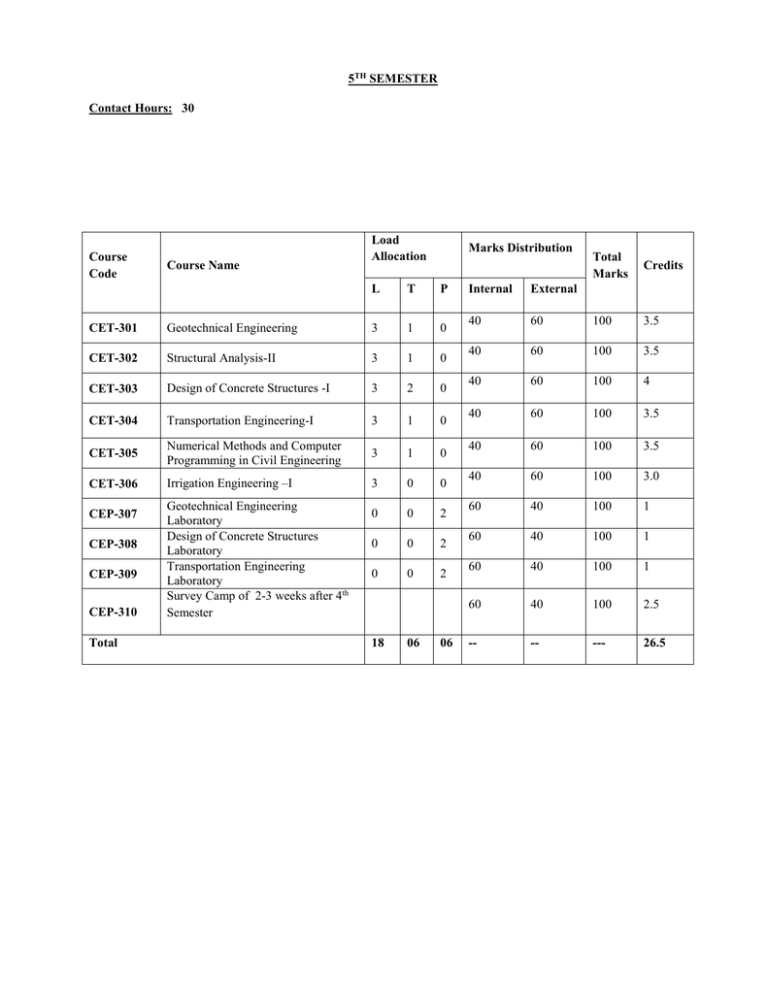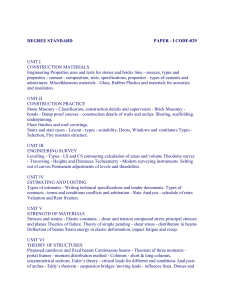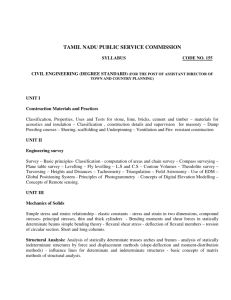Scheme-and-syllabus-5th-Semester
advertisement

5TH SEMESTER Contact Hours: 30 Course Code Course Name Load Allocation Marks Distribution L T P CET-301 Geotechnical Engineering 3 1 0 CET-302 Structural Analysis-II 3 1 0 CET-303 Design of Concrete Structures -I 3 2 0 CET-304 Transportation Engineering-I 3 1 0 CET-305 Numerical Methods and Computer Programming in Civil Engineering 3 1 0 CET-306 Irrigation Engineering –I 3 0 0 0 0 2 0 0 2 0 0 2 CEP-307 CEP-308 CEP-309 CEP-310 Total Geotechnical Engineering Laboratory Design of Concrete Structures Laboratory Transportation Engineering Laboratory Survey Camp of 2-3 weeks after 4th Semester 18 06 06 Total Marks Credits Internal External 40 60 100 3.5 40 60 100 3.5 40 60 100 4 40 60 100 3.5 40 60 100 3.5 40 60 100 3.0 60 40 100 1 60 40 100 1 60 40 100 1 60 40 100 2.5 -- -- --- 26.5 CET-301 Geotechnical Engineering Internal Marks: 40 External Marks: 60 Total Marks: 100 LTP 3 1 0 UNIT-I Introduction: Definition of soil, rock, soil mechanics and foundation engineering, soil formation, Nature of Soil Problems with soil, soil formation, soil structure, minerals (clay mineralogy). Single grained, honey-combed, flocculent and dispersed structures, Soil-Water system, Electrical diffuse double layer, adsorbed water, base-exchange capacity, Isomorphs substitution. Common clay minerals in soil and their structures- Kaolinite, Illite and Montmorillionite. Soil Properties: Basic definitions, phase diagram, water content, specific gravity, void ratio, porosity, unit weight, weight volume relationships, index properties of soil and their determination, sieve analysis - sedimentation analysis, Atterberg limits, classification of soil for engineering purposes - BIS Classification system classification of soils, degree of saturation, density index. UNIT-II Soil Water Flow: Soil water – Various forms, Darcy’s law and its validity, seepage velocity, discharge velocity, constant and variable head permea‐meter, pumping in and out tests, permeability of stratified soils, factors affecting permeability, Laplace’s equation, flow potential flow net and its properties, different methods of drawing flownets, seepage pressure, quick sand, exit gradient, piping, design of filter, principle of total and effective stresses, capillarity conditions in soil, effective and pore pressures Compaction: Definition, Principle and objective of compaction. Standard and Modified Proctor’s tests and their compactive energy. Factors affecting compaction, effect of compaction on soil properties, Field compaction control, Proctor’s needle. Field compaction equipments, Zero air void curve, compaction of cohesionless soils. Suitability of various methods of compaction. Consolidation: Definition, Difference between consolidation and compaction, Mass-spring analogy, basic definitions, estimation of preconsolidation pressure, normally consolidation and over consolidation ratio, Terzaghi’s one dimensional consolidation theory-assumption and limitations, standard solution. Consolidation characteristics of soil (Cc, av, mv and cv), Time rate of consolidation, Methods of accelerating consolidation settlement, laboratory determination of consolidation properties of soil, magnitude and rate of consolidation, settlements, secondary consolidation, compression characteristics of clays and settlement analysis. Determination of coefficient of consolidation by square root of time fitting method, logarithmic time fitting method. UNIT-III Shear Strength : Normal, shear and principal stresses, Columb’s equation, Mohr’s stress circle, Mohr‐Columb failure criteria, Total and effective shear strength parameters, Concept of pore pressure. laboratory determination of shear parameters of soil by direct shear tests, triaxial test, unconfined compression test, Vane shear test, Consolidated drained, consolidated undrained and unconsolidated undrained shear test, pore pressure parameters, Lambe’s p‐q diagram. Lateral Earth Pressure: Active and passive earth pressures, Earth pressure at rest, Earth pressure coefficient and their range. Earth pressure theories- Rankine’s and Coulomb’s –assumptions and limitations, Graphical solutions for active earth pressure (cohesionless soils only) –Culmann’s and Rebhann’s methods, Lateral earth pressure in cohesive and cohesionless soils, Earth pressure distribution. Recommended Books : PunmiaB.C., “Soil Mechanics and Foundation Engineering”, Laxmi Publications Pvt. Ltd., NewDelhi,. RanjanGopaland Rao A.S.R., “Basic And Applied Soil Mechanics”, New Age International Publishers, New Delhi, Venkatramaiah, C. “Geotechnical Engineering”, New Age International Publishers, New Delhi. Khan I.H., “A Text Book of Geotechnical Engineering”, Prentice Hall of India, New Delhi Arora K.R., “Soil Mechanics and Foundation Engineering”, Standard Publishers, New Delhi. CET-302 Structural Analysis-II Internal Marks: 40 External Marks: 60 Total Marks: 100 L T P 3 1 0 UNIT-I Introduction: Classification of structures, equations of equilibrium, stability, static and kinematics indeterminacies, principle of superposition. Castigliano’s 1st and 2nd Theorem, Law of reciprocal deflections, method of least work, induced reactions on statically indeterminate beams, rigid frames and trusses due to yielding of supports. Fixed and Continuous Beams: Analysis of fixed beams, continuous beams and propped cantilevers by moment-area theorem and strain energy method, fixed end moments due to different types of loadings, sinking and rotation of supports, bending moment and shear force diagrams for fixed beams and propped cantilevers, slope and deflection of fixed beams, analysis of continuous beams by the Three moment equation (Clapeyron's theorem) due to different types of loadings, effect of sinking of supports. UNIT-II Two Hinged Arches and Fixed Arches: Application of unit load method, Castigliano’smethod and elastic center method, Influence line for arches. Slope deflection Method: Introduction, slope-deflection equations, analysis of statically indeterminate beams and rigid frames (sway and non-sway type) due to applied loads and uneven support settlements. Moment Distribution Method: Introduction, absolute and relative stiffness of members,stiffness and carry-over factors, distribution factors, analysis of statically indeterminate beams andrigid frames (sway and non-sway type) due to applied loads and uneven support settlements,symmetrical beams and frames with symmetrical, skew-symmetrical and general loading. UNIT-III Rotation Contribution Method: Introduction, basic concept, analysis of statically indeterminate beams and rigid frames (sway and non-sway type) due to applied loadings and yielding of supports, symmetrical beams and frames, general case- storey columns unequal in height and bases fixed or hinged. Approximate Methods of Structural Analysis: Vertical and lateral load analysis of multistory frames, portal, cantilever and substitute-frame methods and their comparison. Influence Lines for Indeterminate Structures: Muller- Breslau principle for statically determinate and indeterminate beams, trusses and rigid frames, influence lines for reactions, shear force and bending moment for statically indeterminate beams, trusses and rigid frames. Recommended Books: B.D Nautiyal “Introduction to Structure Analysis”, New Age International publishers C.K.Wang “Statically indeterminate structures”, McGraw-Hill publishers, Inc., New York, N. Y C.S. Reddy “Basic structural analysis”, Tata McGraw-Hill publishers. CET-303 Design of Concrete Structures-I Internal Marks: 40 External Marks: 60 Total Marks: 100 L T P 3 2 0 Use of Indian Standard IS: 456 (2000), SP-16 is allowed in the examination. Only limit state design method is to be used in this course. UNIT-I Introduction: Reinforced concrete, definition, properties of materials, grades of concrete and reinforcing steel, stressstrain curves, permissible stresses, concrete structural systems-slabs, beams, columns and foundations, design philosophies working stress design, ultimate strength and limit state design method, Codal Provision for RC Elements for Limit State Method. Working Stress Design Method: Design for shear and bond and torsion, Permissible shear strength, maximum shear strength, shear reinforcement and design procedure for shear reinforcement, bond and development length, anchoring and curtailment of bars. Introduction to masonry columns and wall footings. UNIT-II Limit State Design Method – Flexure :Introduction, Limit States, Characteristic values, characteristic strength, characteristic loads, design values for materials and loads, factored loads. Limit State of Collapse (Flexure) Types of failures, assumptions for analysis and design of singly reinforced, doubly reinforced sections, and flanged sections. Design of Slabs: Design of one way slab, two way slab, continuous slabs, isolated footings. UNIT-III Limit State of Collapse (Shear, bond and torsion): Introduction - Design for shear, structural components subjected to torsion, design of rectangular beam section for torsion, development length, continuation of reinforcement (beyond cut off points). Limit State of Collapse (Compression): Columns and their classification, reinforcement in columns, assumptions, short and long (both tied and helical) columns subjected to axial load, short columns subject to axial, uniaxial and biaxial bending. Recommended Books: Nilson and Winter “Design of Concrete Structures”, Tata Mc Graw Hill Publishers Pillai&Menon Reinforced Concrete Design, Oxford Publishers P.C. Vergese “Limit State Design of Reinforced Concrete”, PHI Publishers M.L Gambhir “Design of Reinforced Concrete Technology”, PHI Publishers J.N Bandyopadhyay “Design of Concrete Structure”, PHI Publishers CET-304 Transportation Engineering-I Internal Marks: 40 External Marks: 60 Total Marks: 100 L T P 3 1 0 UNIT-I Introduction: Importance of Transportation, Scope of Highway Engineering, Different Modes of Transportation, Characteristics of Road Transport. Road Development and Planning: Brief history of road development, highway cross section, necessity of transportation planning, classification of roads, road patterns, planning surveys, saturation system, highway planning in India, road development plans, Preparation of Master plan, phasing of plan. Highway Alignment: Requirements of Ideal Alignment, Factors Controlling Highway Alignment, Engineering Surveys for Alignment - Conventional Methods and Modern Methods (Remote Sensing, GIS and GPS techniques), Drawings and Reports, Highway Projects, Realignment and new alignment. Highway Geometric Design: Highway cross‐section elements – Right of Way, Carriage Way, pavement surface characteristics, Camber, Kerbs, Shoulders and Footpaths [IRC Standards], Cross sections of different Class of Roads, Sight distances, PIEV theory, Design of horizontal alignment- design speed, super elevation, transition curves, set back distance, Extra-widening. Design of vertical alignment- Rolling, Limiting, Exceptional and Minimum Gradients, Summit and Valley Curves. UNIT-II Pavement Materials: Desirable Properties and Testing of Highway Materials: Soil – California Bearing Ratio Test, Field Density Test - Aggregate - Crushing, Abrasion, Impact Tests, Water absorption, Flakiness and Elongation indices and Stone polishing value test - Bitumen - Penetration, Ductility, Viscosity, Binder content and Softening point Tests. Bituminous materials and mixtures, Portland cement concrete. Highway Construction: Earthwork, Excavation, Embankment, Different types of base course constructionsEarthen/Gravel Road, Water Bound Macadam, Wet Mix Macadam, Bituminous Pavements, Cement Concrete Pavements. Design and construction of joints in cement concrete pavements. UNIT-III Highway Maintenance: Pavement Failures, Pavement Evaluation, Maintenance and Strengthening Measures. Overlay design by Benkelman Beam Method [Procedure only] – IRC 81:1997 Highway Drainage: Importance, Surface Drainage and Subsoil Drainage, Construction in Water-logged areas. Hill Roads: General considerations, alignment, geometric design and construction, drainage and maintenance problems in hill roads Traffic Engineering: Traffic characteristics, traffic studies and their uses, traffic flow characteristics, traffic control devices, intersections, traffic planning, Trip‐generation models, trip‐distribution models, modal split analysis. Recommended Books: S.K. Khanna and C.E.G. Justo “Highway Engineering”, Nem Chand & Bros., Roorkee. L.R.Kadiyali “Traffic Engineering and Transport Planning”, Khanna Publishers, New Delhi S.K. Sharma “Highway Engineering”, Asia Publishing House CET-305 Numerical Methods& Computer Programming in Civil Engineering Internal Marks: 40 External Marks: 60 Total Marks: 100 L T P 3 1 0 UNIT-I Numerical Computations and Errors Analysis : Introduction, Numbers and their accuracy, Floating point arithmetic, errors in numbers, Computational methods for error estimation, General error formulae‐approximation of a function, series approximations and error propagation in computation. Algebraic and Transcendental Equations: Revision of some basic concepts on polynomial equations, Bisection method, iterative method, Regula‐falsi method, Newton‐Raphson method, Secant method, Generalized Newton’s method for multiple roots, solution of non‐linear simultaneous equations and finding complex roots by Newton‐Raphson method. UNIT-II System of Simultaneous Algebraic Equations: Revision of basic properties of matrices and determinants, Matrix inversion and solution of transcendental and system of algebraic equations‐Gauss elimination method, Jacobi’s method and Gauss‐Seidal method, Eigen values and eigen vectors‐Power method, Jacobi’s method and Householder method. Interpolation and Function Approximations: Least square curve fit and trigonometric approximations, Approximations by trigonometric polynomials and quality of approximations, Finite differences and difference operators, Newtons interpolation formulae, Gauss forward and backward formulae, Sterling, Bessel’s and Evertte’s formulae, Interpolation with unevenly spaced data points‐Lagrange’s interpolation. UNIT-III Numerical Differentiation and Integration: Numerical differentiation, errors in numerical differentiation, Maximum and minimum values of a tabulated function, Numerical integration‐Trapezoidal, Simpson’s 1/3 and 3/8 rules. Software Applications in Civil Engineering :Introduction to C,C++ languages, computer programming for Trapezoidal, Simpson’s 1/3 and 3/8 rules. Recommended Books : J.N. Sharma “Numerical Methods for Engineers and Scientists”, Publisher: Alpha Science Intl Ltd; 1 edition F. B. Hildbrand “Numerical Analysis”, Publisher, Courier Dover Publications. M. K. Jain, S.R.K. Lyngar and R. K. Jain “Numerical Method for Engineers and Scientists”, Narosa Publishing House, New Delhi S.S. Sastry “Introductory Methods of Numerical Analysis”, Publisher, PHI Learning Pvt. Ltd. CET-306 Irrigation Engineering-I Internal Marks: 40 External Marks: 60 Total Marks: 100 L T P 3 0 0 UNIT-I Methods of Irrigation: Definition, Need, Purpose, benefits, ill effects and scope of irrigation, Sources of water for irrigation – surface and ground water. Advantages and disadvantages of irrigation, water requirements of crops, factors affecting water requirement, consumptive use of water, water depth or delta and crop relation, Duty of water, relation between delta, duty and base period, Soil crop relationship and soil fertility.Systems of flow irrigation and lift irrigation, Methods of application of irrigation water.Sprinkler irrigation-advantages & limitations.Planning and design of sprinkler irrigation. Drip irrigation-advantages & limitations, suitability. Canal Irrigation: Classifications of canals, canal alignment, Inundation canals, Bandhara irrigation-advantages and disadvantages. Silt theories-Kennedy's theory, Lacey's theory, Drawbacks in Kennedy's & Lacey's theories, comparison of Lacey's and Kennedy's theories. Design of unlined canals based on Kennedy & Lacey's theories.Suspended and bed loads. UNIT-II Lined Canals: Types of lining, selection of type of lining, Economics of lining, maintenance of lined canals, silt removal, strengthening of channel banks, measurement of discharge in channels, design of lined canals, methods of providing drainage behind lining. Losses in Canals, Waterlogging and Drainage: Losses in canals-Evaporation and seepage, water logging, causes and ill effects of water logging-anti water logging measures. Drainage of land, classification of drains - surface and subsurface drains, Design considerations for surface drains, Advantages and maintenance of tile drains. Investigation and Preparation of Irrigation Projects: Classification of project, Project preparation-investigations, Design of works and drawings, concept of multi - purpose projects, Major, Medium and miner projects, planing of an irrigation project, Economics & financing of irrigation works. Documentation of project report. UNIT-III Tube-Well Irrigation: Types of tube - wells - strainer type, cavity type and slotted type. Type of strainers, Aquifer, porosity, uniformity coefficient, specific yield & specific retention, coefficients of permeability, transmissibility and storage.Yield or discharge of a tube well, Assumptions, Theim&Duputi’s formulae. Interference of tube wells with canal or adjoining tube-wells, optimum capacity, Duty and delta of a tube well. Rehabilitation of tubewell. River Training Works: Objectives, classification of river-training works, Design of Guide Banks. Groynes or spurs Their design and classification ISI. Recommendations of Approach embankments and afflux embankments, pitched Islands, Alficial cut-off objects and design Considerations.River control - objectives and methods. Recommended Books: Dr. Bharat Singh “Irrigation & Water Power Engg.”, publisher Nem Chand & Bros. S.R.Sahasrabudhe “Irrigation Engg. & Hydraulic Structure”, Katson Publishing House. CEP-307 Geotechnical Engineering Laboratory Internal Marks: 60 External Marks: 40 Total Marks: 100 L T P 0 0 2 OBJECTIVE At the end of this course, the student acquires the capacity to test the soil to assess its Engineering and Index properties. 1. 2. 3. 4. 5. 6. 7. 8. 9. 10. 11. 12. Determination of water content by oven drying method Determination of specific gravity by pyconometer Determination of field density and dry unit weight by core cutter method Determination of field density by sand replacement method Grain size analysis of a given sample of sand and determination of coefficient of uniformity and coefficient of curvature by sieve analysis. Determination of grain size distribution by hydrometer analysis Determination of liquid limit of soil by Casagrande and Penetrometer Method. Determination of plastic limit of soil Determination of compaction properties of soil by Standard Proctor Test and Modified Proctor test. Plot of Zero air void line. Determination of shear parameters of soil by direct shear method Unconfined compression test for fine grained soil. Determination of permeability by constant Head Methods and variable head method. Books Recommended:Shamsher Prakash and P.K. Jain, “Soil Testing Engineering, Manual”, Nem Chand & Brothers, Roorkee CEP-308 Design of Concrete Structures Laboratory Internal Marks: 60 External Marks: 40 Total Marks: 100 L T P 0 0 2 OBJECTIVE At the end of the course the student acquires hands on experience in design and preparation of structural drawings for concrete structures normally encountered in Civil Engineering practice. Detailed Working Drawings (Computer Aided):1. 2. 3. 4. 5. Beams: - Singly Reinforced Beam and Double Reinforced beams. Columns: Square Columns, Rectangular and Circular Columns. Slabs: One Way Slab and Two Way Slab. Isolated Footing: Rectangular, Circular and Square Footing. Combined Footing: Rectangular, Trapezoidal, Strap and Raft Footing. Books Recommended: Krishna Raju, “Structural Design & Drawing (Concrete & Steel)”, CBS Publishers.. CEP-309 Transportation Engineering Laboratory Internal Marks: 60 External Marks: 40 Total Marks: 100 L T P 0 0 2 OBJECTIVE To study the strength aspects and to learn the principles and procedures of testing Highway materials I. TESTS ON AGGREGATES 1. To determine the impact value of aggregates. 2. To determine the crushing value of aggregates . 3. To determine the flakiness and elongation index of aggregates. 4. To perform Los‐Angeles and test on aggregates. 5. To determine the specific gravity and water absorption of aggregates. 6. To determine the CBR value of the subgrade soil sample. II. TESTS ON BITUMEN 7. To perform penetration test on bitumen 8. To determine the softening point of bitumen material. 9. To determine the ductility value of a bitumen Material. 10. To determine flash and fire point of bitumen. III. TESTS ON BITUMINOUS MIXES 11. Determination of Binder Content 12. Marshall Stability and Flow values 13. Stripping Test. Books/Manuals Recommended : Khanna S.K., and Justo C.E.G. “Highway Testing Manual”, Nem Chand and Brothers, Roorkee.




